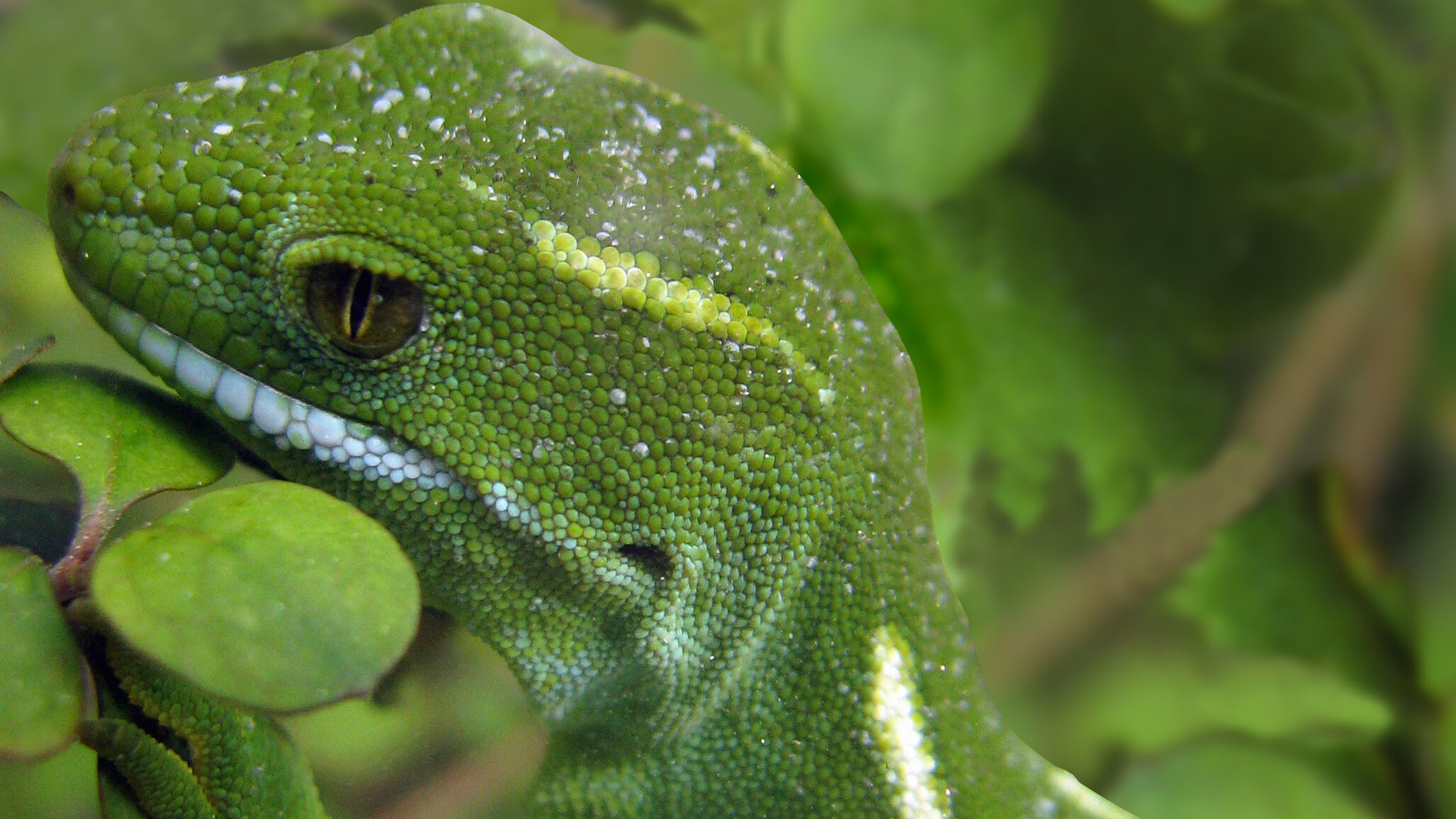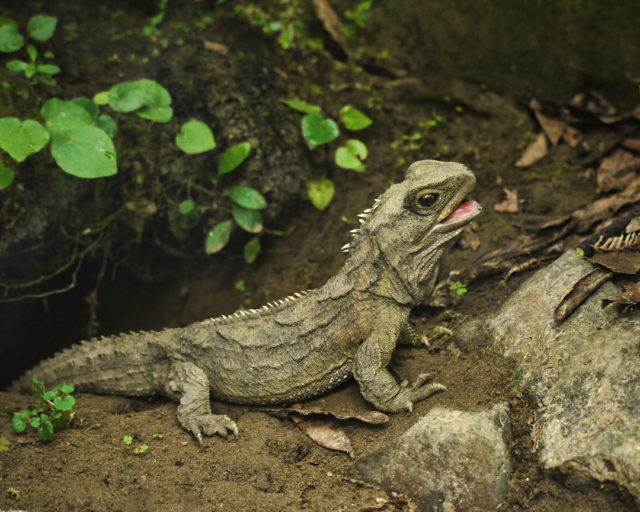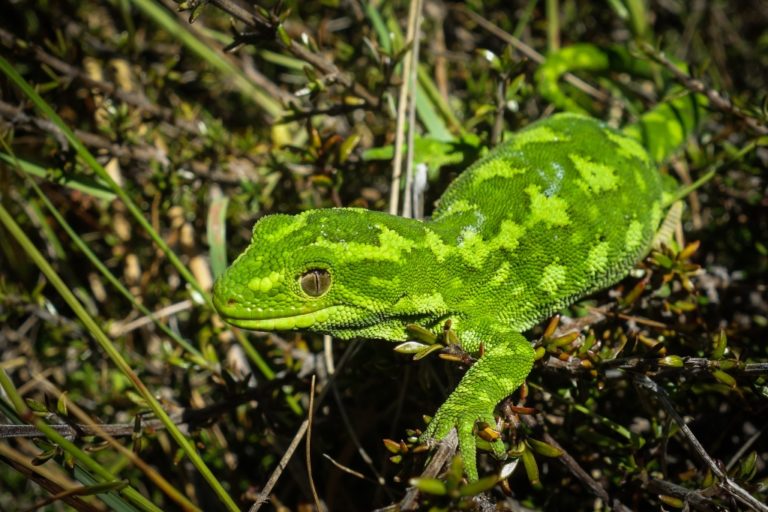Our native skinks and geckos have evolved with predators that rely on eyesight to spot them – predatory birds, other lizards and tuatara. For a lizard, having camouflage skin and standing very, very still is a great defence if something bigger is trying to see you – not so great, however, if your predator is a mammal relying on scent to detect its next meal.

Joanne Monks, Nicola Nelson, Charles Daugherty, Dianne Brunton and Richard Shine have been testing how our lizards detect and respond to predators to see whether evolution in isolation from mammals has had consequences for their self-defence mechanisms. The results of their study are published in the latest issue of the New Zealand Journal of Ecology.
“Under a pre-human predation regime, predators of native New Zealand lizards were predominantly birds, especially kingfishers, owls, gulls, rails, harriers, adzebills and larger reptiles, including tuatara. After mammals were introduced to New Zealand, tuatara and some larger lizard species became extinct on the mainland and were restricted to mammal-free outlying islands, such as North Brother and Stephens Islands. Thus, mammals (especially rodents, cats and mustelids) have replaced larger reptiles as lizard predators throughout much of New Zealand.”
One surprising thing is that some lizards have been here much longer than others.
“Geckos are thought to have colonised New Zealand 40.2–24.4 million years ago from Australia and skinks approximately 18.3 million years ago from New Caledonia via overwater dispersal and island hopping. Thus, both groups have been isolated from mammalian predators for several millennia.”
Their defence mechanisms reflect the types of predators they found here.
“New Zealand lizards coevolved with primarily visual native predatory birds, other lizards and tuatara as predators. The visual crypsis and secretive behaviours exhibited by native lizards are presumably the results of strong selective pressure to avoid detection by native predators. However, this strategy may be unsuitable for the avoidance of novel mammalian predators that hunt primarily using scent and have a speed advantage over ectothermic prey, particularly in cool temperate locations.”
Hiding hasn’t been their only defence. Some geckos can smell tuatara poo for instance.

“Endemic diurnal geckos, Naultinus manukanus, show some ability to detect strong (faecal) cues of native reptilian predators (tuatara) as well as conspecifics and food, suggesting that New Zealand lizards can use chemosignals for a range of purposes, possibly including their antipredator behaviour. However, the extent to which New Zealand lizards are able to detect and behaviourally respond to native and introduced predators using chemosensory cues is unknown.”
Since humans, accompanied by rats (first kiore, then Norway and ship rats), arrived in Aotearoa, our lizards have been vulnerable.
“New Zealand reptiles did not encounter predatory mammals for up to 16 million years, prior to human contact (around 800 years ago). Islands never reached by mammals or from which mammals are removed often support high lizard diversity and abundance. For example, 41% of the 65 extant endemic reptile species in New Zealand now survive largely or entirely on rat-free offshore islands. In contrast, reptiles that coevolved with mammals have not been so susceptible to invasive mammals.”
Lizards in other parts of the world, survive with rats around – so why are New Zealand lizards different? It’s all about the evolutionary power of natural selection – or, in New Zealand’s case, a lack of natural selection – for defence mechanisms that simply weren’t needed here.
“Evolutionary isolation from common predator guilds may lead to relaxed selection and the loss of costly antipredator traits and behaviours among prey species. Investigating how predators influence antipredator traits is essential to understanding why certain species are particularly vulnerable to novel predators.”
Researchers currently have only limited understanding of which antipredator mechanisms are lost through relaxed selection, and how they influence the ability of prey to respond to novel predatory threats. New Zealand’s lizard species offer an ideal opportunity to learn more about the process.
“The varying effects on native lizard populations of the relatively recent and patchy history of mammalian introductions to New Zealand’s islands provide an opportunity to examine the consequences of relaxed selection. Focal lizard populations were isolated from predatory mammals for up to 16 million years; some now co-occur with mammals, while others remain in mammal-free locations. A skink species (plague skink) that evolved with mammals and has recently been introduced to New Zealand is included for comparison.”
The researchers investigated the ability of lizards to recognise chemicals of predatory tuatara and ship rats, which established in the North Island after 1860. The scope of the study was limited to odour-related behaviour.
“We test whether experience of, and evolution with, mammalian predators determines behavioural patterns and chemosensory predator recognition abilities of lizard prey by addressing the following questions:
- Do predator detection abilities vary among species isolated from mammalian predators? We compare four lizard species on a mammal-free offshore island. The species encompassed skinks and geckos, including species that are rare or common at locations where they now coexist with mammals.
- Do behaviours and predator detection abilities vary across populations of the same species according to recent exposure to mammalian predators? We compare populations of widespread and abundant native skinks and geckos from proximate geographic locations that are either affected by introduced mammals or mammal-free.
- Does coevolution with mammalian predators influence lizard behaviours and predator detection abilities? We compare native skinks that were evolutionarily isolated from mammalian predators with an introduced skink (plague skink) that coevolved with mammals and snakes.
Two North Island locations where introduced mammals are present, Pukerua Bay and Turakirae Head, and two mammal-free locations, North Brother Island (4 ha) and Stephens Island (150 ha) in adjacent Cook Strait were the study sites for the project. Introduced plague skinks were collected from the Otara and Mount Wellington suburbs in Auckland.

All skinks and geckos used in this study were captured through pitfall trapping or hand searching. Once captured, they were well looked after for the brief time they were in captivity and carefully returned home at the end of the experiment.
“Lizards captured on Stephens and North Brother Islands were held temporarily in captivity (in temporary laboratories inside buildings) on the respective islands for behavioural trials. Those from mainland sites were transported by vehicle in cotton bags inside a cool, ventilated container to either the Victoria University of Wellington (lizards from Pukerua Bay and Turakirae Head) or the Albany campus of Massey University (plague skinks from Auckland) for behavioural trials.”
“All lizards were kept individually in 2 L plastic containers with 1 × 1 mm wire mesh (165 × 120 mm) in the lid for ventilation and to enable basking. Food and water were supplied ad libitum, the food consisting of mealworm larvae and/or pureed pear. We minimised the time lizards were held in captivity for this research as much as possible (range 7 to 19 days) and returned them to the wild at their exact point of capture.”
So how can you tell if a lizard has detected the scent of a predator? How do you assess a gecko’s defence response?
“Prey animals may exhibit a suite of behavioural responses following exposure to predators. For example, lizard avoidance of mammalian predators can include running, remaining motionless, vibrating the tail laterally against the substrate, defecating and/or vocalising. In contrast, we expect normal maintenance behaviour of lizards to include a greater proportion of slow, stalking walk behaviour and snout licking. Therefore, we chose to measure a variety of behavioural actions that represent both antipredator defences and normal maintenance behaviours but acknowledge that a full spectrum of antipredator responses could not be measured (e.g. apprehension). The relative proportions of these behaviours were used to indicate responsiveness to chemical stimuli.”
Normal behaviour showed distinct differences between skinks and geckos.

“Geckos were more active than skinks during trials, spending on average 43% of time moving about the enclosure, compared with 21% of time by skinks. Running by either skinks or geckos was infrequently observed, and skinks seldom walked. Unsurprisingly, geckos also spent more time climbing on the walls of the enclosure. Rate of tongue flicking of skinks was twice that of geckos, but skinks did not exhibit the maintenance behaviour of snout licking, which averaged 5 licks per 8 minute trial in geckos.”
Key results were:
- Geckos responded to predator scent but skinks did not.
- Behaviours of geckos and skinks were correlated with the presence of mammals. Exposure to mammals induced greater activity and less antipredator freeze behaviour
- Exposure to mammals did not influence responses to predator chemical cues.
- Introduced and native skinks responded differently to chemical cues. Introduced skinks shoed elevated tongue flicking and movements of head, tail and limbs in response to novel and rat cues.
- Introduced skinks were more active than native skinks; they spent more time slow walking, walking and nudging wall, and less time motionless.
“We find little evidence to suggest that New Zealand lizards detect and respond to native or introduced predators using chemical cues from urine or faeces alone. We acknowledge that multiple predator stimuli including direct cues (e.g. visual, auditory) that indicate imminent predation risk may be needed to elicit a full antipredator response. Skinks do not appear to differentiate at all between scent stimuli presented, while geckos show some scent recognition, but respond to a novel cue at least as much as they do to predator chemical cues.”
Although chemoreception alone did not seem to affect behavioural patterns of New Zealand lizards, exposure to introduced predators in their ‘home’ environment did appear to affect their behaviour.
“The behavioural patterns of New Zealand lizards are highly correlated with the predator regimes to which they are exposed. The presence or absence of mammals from a site had far greater explanatory power for behavioural differences than did environmental factors. Recent coexistence with predatory mammals seems to have induced a shift among lizards from antipredator freeze behaviour towards greater activity.”
The results suggest that behaviour of geckos and skinks can change in response to new types of predators.
“Our findings suggest that when predatory mammals are introduced into a system formerly dominated by avian predators, they induce a shift from primarily visual antipredator strategies (freeze behaviours and crypsis) that enable avoiding detection to one in which escape behaviours also play an important role. However, predator chemical cues do not appear to induce specific antipredator responses in lizards, indicating that these behavioural patterns are not linked to chemosensory predator detection alone.”
Although New Zealand lizards that evolved in isolation from mammalian predators now show avoidance behaviour towards this new threat, the mechanisms through which they detect introduced mammals are yet to be discovered.
The full research report is published in the New Zealand Journal of Ecology and freely available online.

